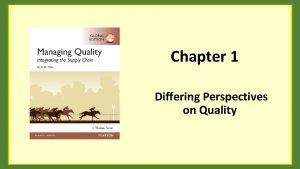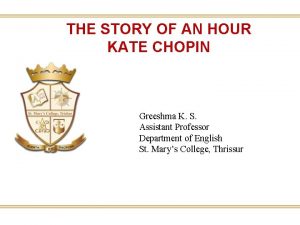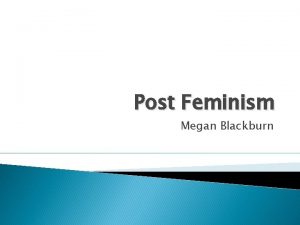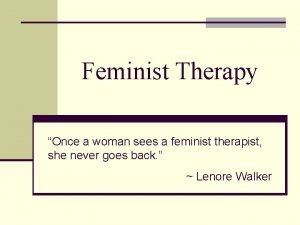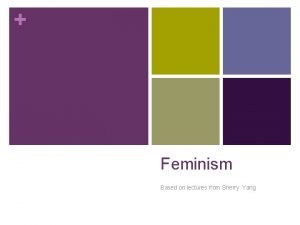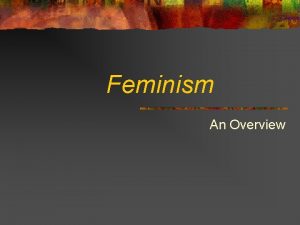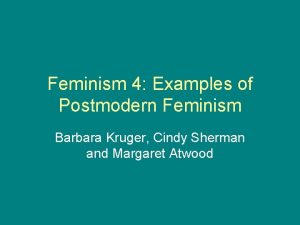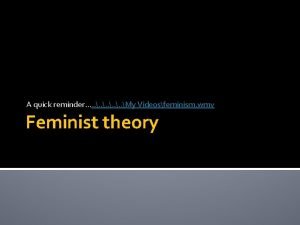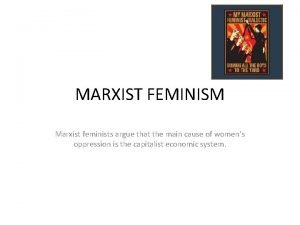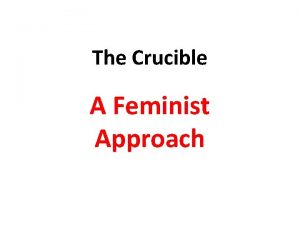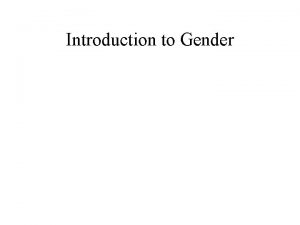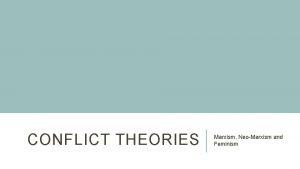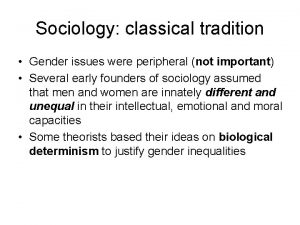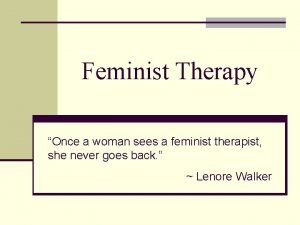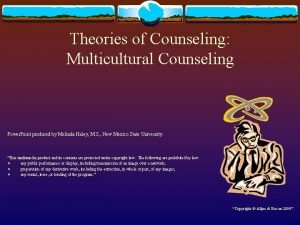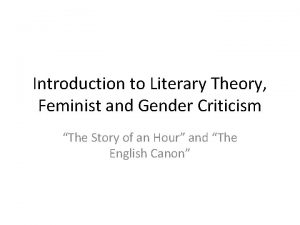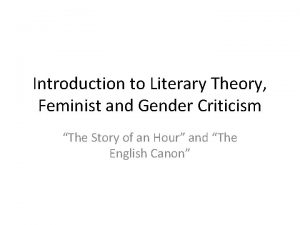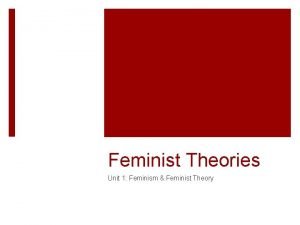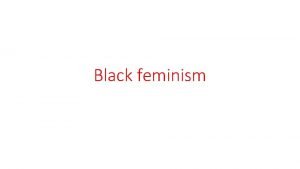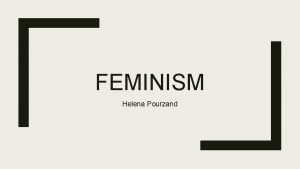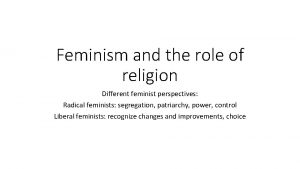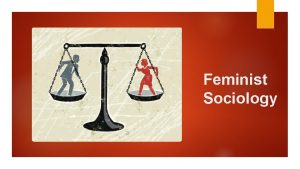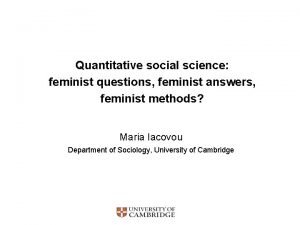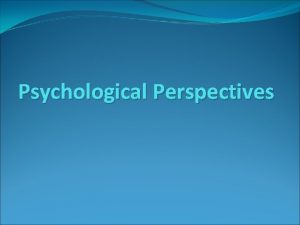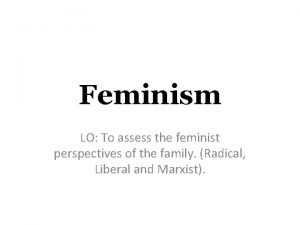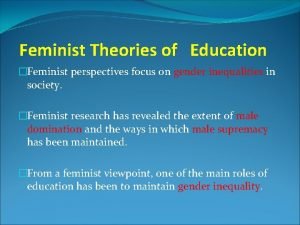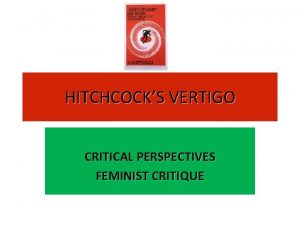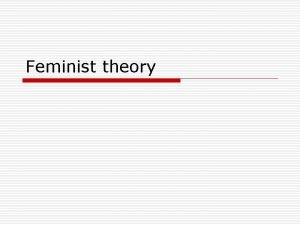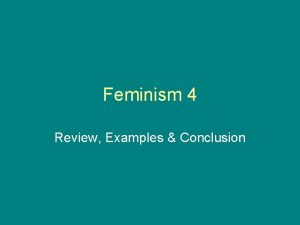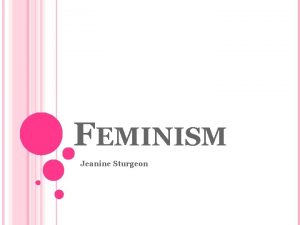Feminism Religion Outline different feminist perspectives on religion


























- Slides: 26

Feminism & Religion • Outline different feminist perspectives on religion • Understand arguments of de Beauvoir (1953) and El Saadawi (1980) • Recognise there is resistance to female religious oppression • Evaluate the feminist argument

1) Liberal Feminists Differences between men & women are due to: - socialisation - sexist laws & rules We need : - non-gendered socialisation of children - equality laws • Church is unequal • Women should be allowed to have the same religious jobs as men

2) Radical Feminists • • Men are responsible for women’s oppression Men directly benefit from women’s low social status Men dominate women in society Religion = patriarchal (Daly, 1973) • Religions have specific rules for women meant to disempower them and keep them subservient to male control E. g. - Catholic women to cover heads in Church - Muslim women to wear Burqa in public

3) Marxist Feminists • Capitalism reinforces women’s inferior social status • Women provide free domestic labour (cook, clean, rear children) • Capitalism benefits from this, as husbands are able to work longer hours • Religion = tool of women’s oppression under capitalism • Church reinforces traditional gender roles • This benefits the ruling capitalist class

Simone de Beauvoir (1953) Religion confirms the social order, it justifies her resignation, by giving hope of a better future in a sexless heaven • Western-Christian perspective • Marxism = religion controls classes • Feminism = religion controls women

de Beauvoir (1953) • Religion is used by the oppressors (men) to control the oppressed (women) • Religion compensates women for the 2 nd class status • Men have control over religious beliefs • Divine authority supports male dominance There must be a religion for women as there must be one for the common people, and for exactly the same reasons Man is master by divine right; the fear of God will repress any impulse towards revolt in the downtrodden female

de Beauvoir (1953) • Modern day society – religion is an instrument of patriarchal deception • Women are deceived by religion into thinking of themselves as equal to men (despite evident inequality) • Religion maintains a ‘status quo’ in which women are unequal (like Marx’s false consciousness)

de Beauvoir (1953) Women are vital for religion : Much of the work for religious organisations Introduce children to religious beliefs (through primary socialisation)

Nawal El Saadawi (1980) • Arab-Egyptian perspective • Fighting for women’s rights in Arab world • Put in prison for her political activities

El Saadawi (1980) • Religion = creates / perpetuates oppression • Men distort religion to: - serve their own interests - justify positions Men are in charge of - legitimate the oppression of women… hence good women are obedient The Koran

El Saadawi (1980) If religion comes from God, how can it order man to cut off an organ created by Him? • Her personal experience of oppression - female circumcision at age 10 • Oppression of women isn’t directly caused by religion / Islam (e. g. Female circumcision practised in variety of countries, not all are Islamic) • Other religions are (or have been) equally oppressive to women through male monopolisation

Oppression of Women Judaism • Power of Abraham • Hebrew household has patriarchal family • Father has uncontested & undivided authority

Oppression of Women Islam • • • Men own herds of horses, camels & sheep Very restrictive marriage laws for women Men are allowed several wives (polygamy) Men have the choice to divorce Adultery = women stoned to death

Oppression of Women Christianity • 14 th century – women who treated illnesses without special training were executed as witches – essentially for possessing knowledge

El Saadawi (1980) Patriarchal • Religion became patriarchal through misinterpretations of religious beliefs Can you think of any examples? Story of creation – Eve portrayed as temptress who created sin

El Saadawi (1980) Conclusions • The only way for women to improve their lot = struggle for their own liberation • Women are benefitting from social revolutions whenever they occur

• Feminists argue that women have not always been subordinate to men within religion. Armstrong argues that early religion often placed women at the centre. For example, earth mother goddess, fertility cults and female priesthoods were found throughout the Middle East until about 6, 000 years ago. • However, from about 4, 000 years ago, the rise of monotheistic religions saw the establishment of a single, all-powerful male God, such as the Hebrew’s Jehovah, and male prophets such as Abraham/Ibrahim, the first prophet of Judaism, Christianity and Islam. • Thus, religion now contributes to women’s oppression. Like Saadawi, Armstrong sees the rise of monotheism as legitimating the power of men over women.

WOODHEAD: RELIGIOUS FEMINISM • Woodhead criticises feminist explanations that simply equate religion with patriarchy and the oppression of women. While accepting that much traditional religion is patriarchal, she emphasises that this is not true of all religion. She argues that there are ‘religious forms of feminism’- ways in which women use religion to gain freedom. • Woodhead uses the hiijab or veil worn by many Muslim women. While Western feminists tend to see it as a symbol of oppression, to the wearer it may symbolise resistance to oppression. Woodhead argues that some Muslim women choose to wear the hiijab to escape the confines of the home and enter education and employment. For them, the hiijab is a symbol of liberation that enables them to enter the public sphere without losing their culture and history.

Oppressive practices? There has been a defence –from Muslim women- for some practices considered ‘oppressive’ – e. g. Muslim veil • • • Proud of their religion Avoid stares from men Want others to know you’re Muslim Liberating to have freedom of movement Able to communicate without being on show Rejection of Western cultural imperialism of notions about femininity / sexuality

WOODHEAD - Continued… • Women also use religion to gain status and respect for their roles within the private sphere of home and family e. g. belonging to an evangelical group can be empowering for some women. For instance, a strongly held belief among evangelicals is the that men should respect women. This gives women power to influence men’s behaviour by insisting that they practise what they preach and refrain from ‘macho’ actions. • Similarly, women make use of activities linked to the church, such as bible study groups to share experiences and to find support. • The position of women within some religions is changing. For instance the Church of England has permitted women’s ordination into the priesthood since 1992 and about a fifth of all priests are now female.

Resistance to this oppression Holm (1994) • There are ‘signs of hope’ in religious situations of women • There are many female Christian Bishops Gross (1994) • Signs of ‘post-patriarchal’ Buddhism developing in Western countries

Resistance to this oppression Badawi (1994) Positive aspects of Islam – Islamic women keep their own family name – Choice over which interpretation of Islam they give their allegiance to (some have more positive attitudes to women) Wright (1994) Reform Judaism : women are able to become Rabbis since 1972

Evaluating Feminism Practices that may appear to be oppressive can have many meanings Watson (1994) Ethnocentrism = Need to be careful when interpreting religious practices from different cultures

Evaluating Feminism Need to discover the meaning of those practices by asking its believers (not just reading & observing) AND accepting plurality of experience within any given group The situation of women in some religious organisations has improved E. g. women Christian ministers & Bishops

Evaluating Feminism Not all religions are oppressive to women… E. g. Quakers & Unitarians are committed to gender equality (Aldridge, 2000)

Type of Feminism / Theorist Summary (AO 1) Commentary / Application / Evaluation (AO 2)
 Perspectives of quality
Perspectives of quality The story of an hour literary devices
The story of an hour literary devices What is post feminism
What is post feminism Feminist perspective of snow white
Feminist perspective of snow white Cultural feminism example
Cultural feminism example Principles of feminism
Principles of feminism What is feminism
What is feminism Postmodern feminism
Postmodern feminism Barbara kruger marilyn monroe
Barbara kruger marilyn monroe Objectives
Objectives Feminist waves
Feminist waves Marxist feminism theory
Marxist feminism theory Formalist structuralist critic
Formalist structuralist critic Feminism in the secret life of bees
Feminism in the secret life of bees Feminism in the crucible
Feminism in the crucible Marxist feminism example
Marxist feminism example Marxism and feminism similarities
Marxism and feminism similarities Subject matter of sociology
Subject matter of sociology Radical feminism slideshare
Radical feminism slideshare Readers response theory
Readers response theory Feminist therapy
Feminist therapy Example of topic outline and sentence outline
Example of topic outline and sentence outline Western religion vs eastern religion
Western religion vs eastern religion Multicultural counseling theory
Multicultural counseling theory Reader response criticism
Reader response criticism Feminist criticism of the story of an hour
Feminist criticism of the story of an hour Gender criticism definition
Gender criticism definition
